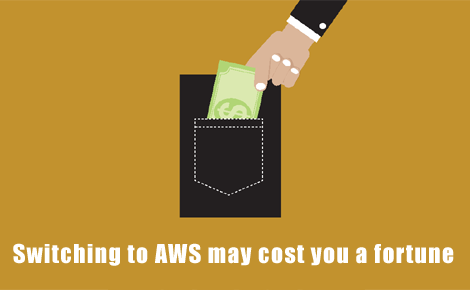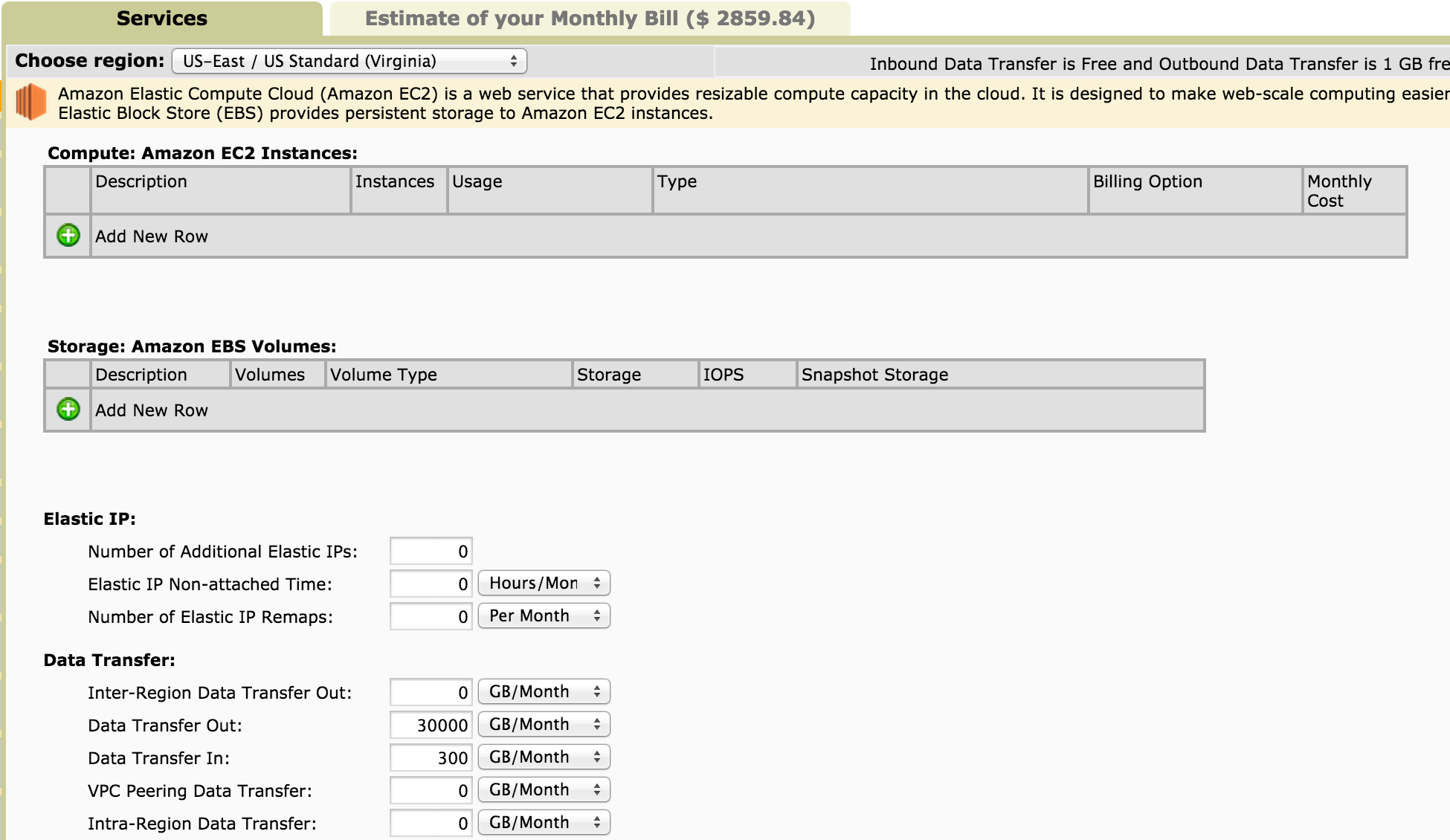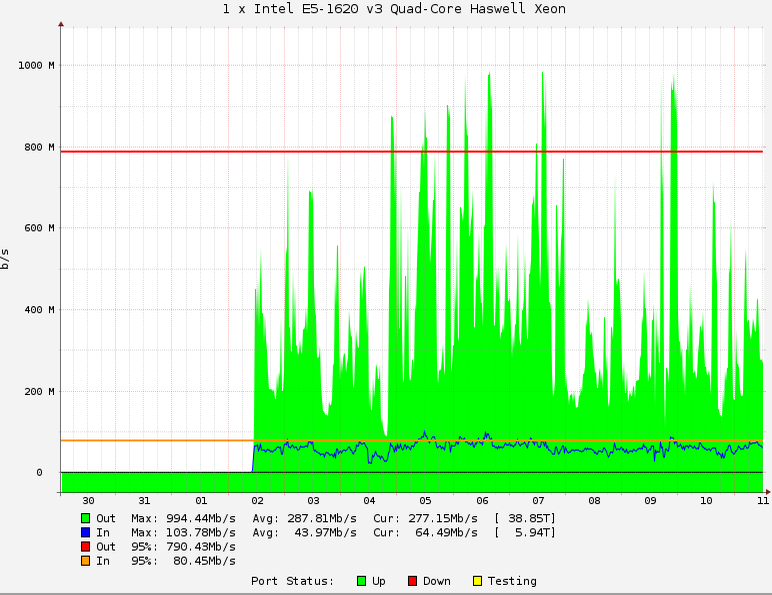
Every month, we lose a couple of customers to Amazon’s Cloud or AWS (Amazon Web Services) and every month we have another couple of customers sign up with us having just cancelled their AWS solution. Each time their reasoning for leaving AWS is the same, “way more expensive and way less performance than we expected, especially when compared to what we get from a dedicated server.” This conversation has come up so frequently we thought it was worth doing a little analysis to find out exactly what these folks are talking about, and why AWS costs so much.
It only took me about 30 seconds with the AWS EC2 price calculator to figure out where that “way more expensive” issue might be coming from in the AWS cost. Before I dive into my findings, let me give you a quick history on the evolution of bandwidth pricing on bare-metal servers.

Over the last few years, the amount of bandwidth included with a dedicated server has increased industry wide. A decade ago, it was common for an entry-level server to include 1,000GB (gigabyte) of monthly data transfer; then it was 2,000GB; then 3,000GB. Today, you will now find most bare-metal hosting providers including anywhere from 5TB to 20TB with every server they offer. A lot of times, this is on a 1Gbps (gigabits per second) port. The data center and hosting industry has consistently increased the included server bandwidth for a couple of reasons:
- First, the usage of the worldwide web increases every day… every hour really. With that increased usage comes more content, more streaming, more videos, and in general, much more data flowing across the web. Ten years ago, our average customer was fine with 1,000GB of bandwidth. Heck, they were fine with 500GB. But today, our average customers are transferring thousands of gigabytes every month and bursting well over 100Mbps (megabits per second).
- Secondly, the price of transit, i.e. bandwidth, has come down drastically. Because of the increased bandwidth usage described above, hosting providers are now able to bite off huge commitments with network providers like Level 3, Verizon, and Comcast. The more network throughput a data center commits to each month, the lower the price per Mbps from the carriers. Additionally, the base price, even on a small 1Gbps commit, with these network providers has come down from $15-$30 per Mbps back in 2005 to below $5 per Mbps. When you get into 10Gbps+ commits, pricing can be driven down to below $1 per Mbps. So, supply and demand has led to more for less, resulting in a better price and experience for the end user.

Now back to the AWS EC2 price calculator for an estimated AWS cost. One of the very first things you are able to enter is the amount of inbound and outbound AWS bandwidth required. I started with what I thought was a pretty modest amount of usage, 3,000GB out and 300GB in, or the equivalent of just 10Mbps sustained throughout a month. The cost for this bandwidth, before any compute, backup, IPs or anything else was added is $268/month. I then began incrementally adding more AWS bandwidth in nominal chunks. Below is a breakdown of what I found:
- 3,000GB outbound, 300GB inbound (10Mbps) – $268/month
- 9,000GB outbound, 1,000GB inbound (30Mbps) – $808/month
- 15,000GB outbound, 1,500GB inbound (50Mbps) – $1,457/month
- 30,000GB outbound, 3,000GB inbound (100Mbps) – $2,859/month (shown in the screenshot above)
- 150,000GB outbound, 15,000GB inbound (500Mbps) – $12,410/month
Keep in mind, an entry-level single-tenant guaranteed resource dedicated server typically includes a Quad-Core Xeon CPU with 8GB RAM, 500GB Hdd, and, most importantly, 10TB bandwidth (10,000GB or just over 30Mbps sustained). A server like this costs about $99- $199 per month. The bottom line is, if your online presence requires 10TB of bandwidth or more, you will likely spend at least $600 more every month (or $7,000 more per year) than you would with a dedicated server while potentially experiencing worse performance. With some providers specifically targeting high-bandwidth users, ourselves included, it is not uncommon to find servers for $200-$600 per month that include 500Mbps or 1Gbps unmetered bandwidth. The cost comparison under this scenario is even more staggering. Again, the costs I produced from the EC2 price calculator are before any actual compute or storage capacity was considered.

Another option is Amazon’s CloudFront CDN solution. Since a CDN is predicated on high-bandwidth usage, I had assumed the pricing here would close the gap with bare-metal. However, while the price was lower, it was still far higher than the costs associated with a dedicated server. For this evaluation, to keep things simple, I stuck with only distributing my content within the US. Keep in mind, the pricing below does not include the additional cost of $.02 per GB for linking your source server to the CDN or the just under a penny cost for each HTTP and HTTPS request to your content. In the end though, every 10,000 pennies is another $100.
- 10TB (10,000GB) of CDN bandwidth -$850/month
- 20TB of CDN bandwidth – $1,650/month
- 50TB of CDN bandwidth – $4,050/month
- 100TB of CDN bandwidth – $7,050/month
In summary, it is clear that AWS has its benefits, hence the $5 billion in estimated revenue it will produce this year. However, if you are a heavy user of bandwidth, or even a moderate user for that matter, it seems to me it will cost you a considerable amount of money every month within the AWS cloud. To give some perspective of how this pricing structure would affect some of our dedicated server customers, we just turned up 20 Linux Quad-Core Xeon (with hyper threading) servers last week for 1 customer. Each server today is pushing about 650Mbps of bandwidth at a cost of just over $600 per month per server. This one customer is saving an estimated $290,000 every month when compared to AWS. Now, this is likely an extreme example of how a dedicated server can save when compared to Amazon Web Services, but even a few hundred dollars each month is often a big deal to a small or medium sized company, which just so happens to describe the majority of companies out there.
Additional Links:
Looking for more information on Dedicated Servers? Search our Knowledge Base!
In need of more great content? Interested in cPanel, Private Cloud, or Edge Computing? Check out our recent posts for more news, guides, and industry insights!

15 thoughts on “Why Switching to AWS May Cost You A Fortune”
Very nice article, totally what I needed.
I started programming 22 years ago when IT Managers were capable of estimating the resource requirements for the systems they were writing. You had to do a load test, calculate memory consumption, performance analysis, etc and come up with specs in terms of number of machines needed, CPU, and memory required.
Now, IT managers have no clue about doing this assessment, and resolve their incompetence by just paying Jeff Bezos to do what they should do.
BS. And it’s “tests”.
@Erik: Ah, the good old way of not being able to say anything useful to the argument other than correcting other people’s grammar. Not elaborating which points you are disagreeing with, nor stating why you think it’s bullshit. Heer, have som mor garmar misstakes too correct.
I agree with John to a degree, but in my opinion the further we go from machine code to more higher level languages we tend to rely more and more on dependencies out of our scopes. We could do some tests to narrow down the necessary requirements for the software to run properly, but it’s pretty time consuming and of course time is money for companies.
Eric. You actually proved John’s point by not even knowing what a load test is. You assumed he wanted to say “load of tests”. You must be an IT manager with no IT knowledge whatsoever. There are hundreds of people like you in my company.
Small business, just me doing some blog posts, I don’t think I used AWS that much last month, and then I got my bill. $416. I am still in stock. It sucks, I was just getting used to S3 (should have done more research) and now I need to find something else after 30 days.
Yeah. Just this week, I was looking over AWS and Azure pricing. They price like building contractors. As if money grew on trees.
Company I work for, a huge finance company, I can only imagine how much they spend on AWS. Me, since I don’t have any insight into billing, kept creating servers left and right, like anyone else in the company. Then, a friend of mine asked me to look up AWS, to see if he can port his small business to the cloud. I was astonished with the pricing. I guess it makes sense for large businesses since they have a lot of overhead expenses, but for my friend who had me set up his server years ago and his only problem is losing power from time to time, AWS/Azure would be just a money pit.
This is a good article, thanks for the details and calculations. However, I manage an AWS production environment for a financial company (hedge fund) as a consultant. We average a volume of around 100,000 trades a month, considering max size of a trade is around 1200KB, we use somewhere around 80/125GB inbound bandwidth. Our overall cost is around 178$/month for a fully redundant, geo-replicated EC2. I am not sure what kind of a business averages 10TB a month but certainly not middle sized financial companies on core business applications. Having said that we save around $230K a year from not having to allocate budget upfront for machines, SAs, having to patch them for an onprem or co-located hardware, not mention the financial burden of capex vs opex. This analysis is a good one but does not clearly articulate why AWS would cost you a fortune to switch. I understand that Hivelocity provides excellent customer service but the article is skewed and does not justify not to the switch to the cloud for majority of the IT groups, hence the undeniable increase in cloud vendor usage. If you are a company that uses 10TB or more in outbound volume, than yes that’s probably a different story.
We may be able to distill everyone’s points/arguments down to this: “Do your homework and figure out what is going to work best for you in your particular situation with the data you have and calculations you’ve made. Use realistic numbers, consider all expenditures, and don’t assume.”
Can someone tell me if TCP/IP overhead is calculated into data transfer costs? The reason I ask is that if you add VPN/IPsec to the link, this will add somewhere around 10 to 30% overhead. So I’m guessing that by adding VPN, I increase my outbound data usage costs by 10 to 30% for the same amount of traffic?
this great and informative for me thanks for sharing
Thank you so much for sharing an amazing information. Appreciated. I am looking forward for more blogs and articles about AWS and cloud computing.
I was astonished with the pricing. I guess it makes sense for large businesses since they have a lot of overhead expenses, but for my friend who had me set up his server years ago and his only problem is losing power from time to time, AWS/Azure would be just a money pit.
Really very helpful article. keep it up!
I loved reading your blog post. The information you provided was very valuable and insightful. Keep up the great work!